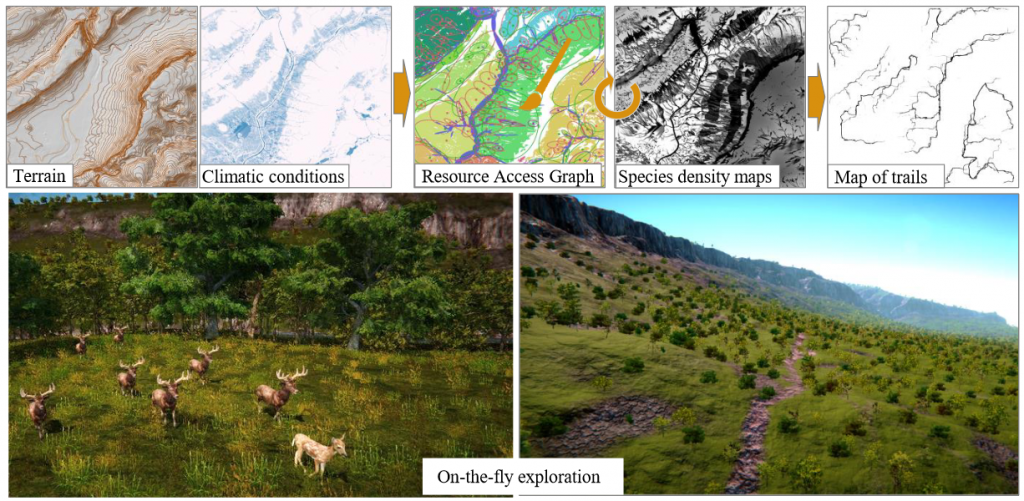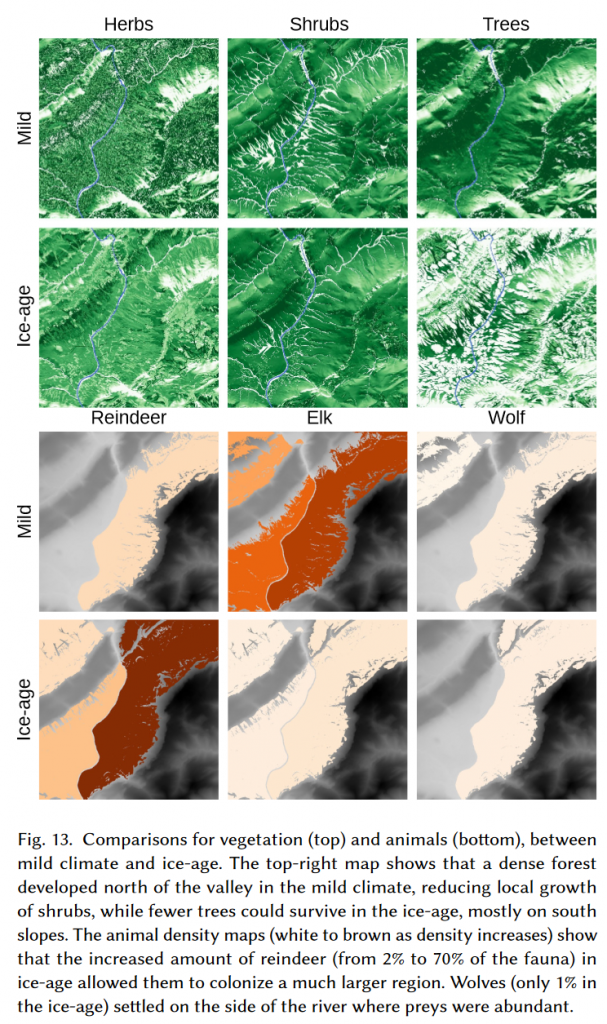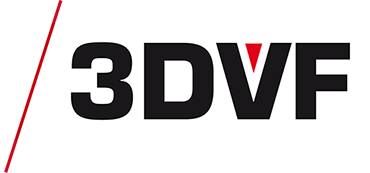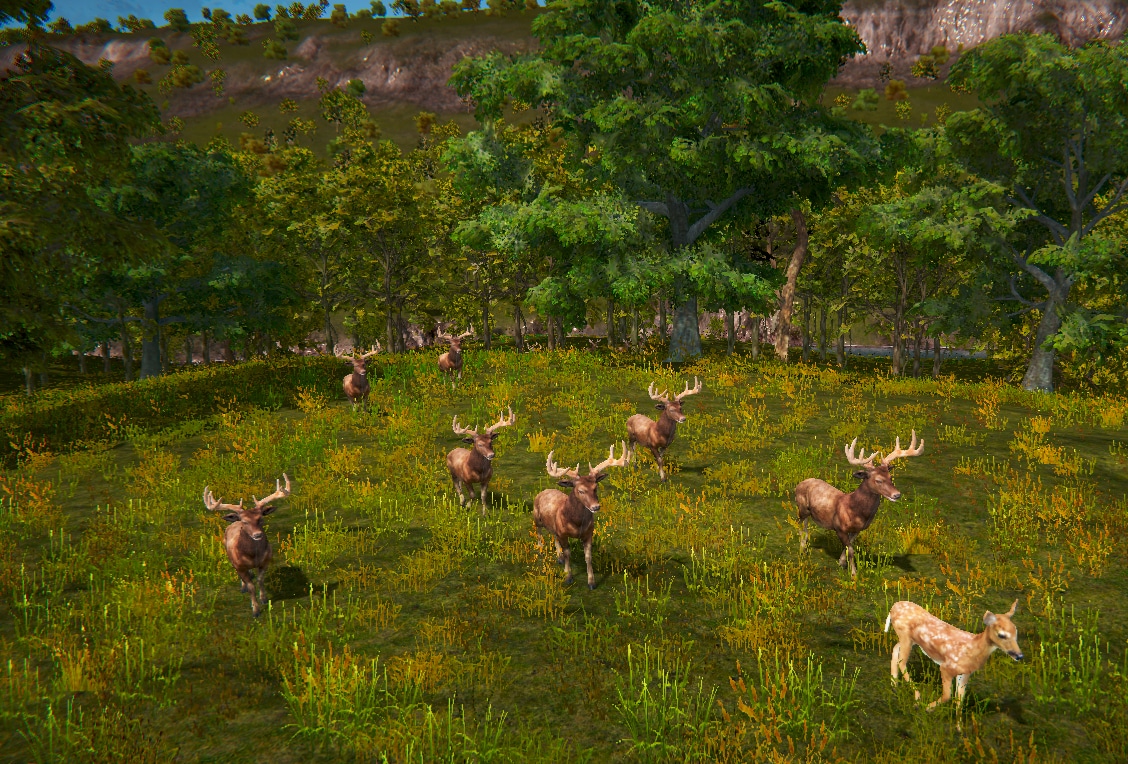This article is also available in:
Français
Pierre Ecormier-Nocca, Guillaume Cordonnier, Philippe Carrez, Anne‑marie Moigne, Pooran Memari, et al. present their latest paper at SIGGRAPH 2021: Authoring Consistent Landscapes with Flora and Fauna.
A landscape teeming with flora and fauna, in just a few minutes
The research team present a novel method for authoring landscapes with flora and fauna while considering their mutual interactions and climatic conditions set by the user.
In other words, instead of placing trees and animals by hand (which is time-consuming) or using a random scattering approach (which probably won’t create realistic results), this method takes into account the mutual interactions between species to automate the process. User input includes “climatic conditions, desired proportions between competing species and their dependency through the food-chain”. Density maps are then generated for each species, as well as their daily circuits and a new terrain with eroded trails. You can even explore the resulting landscape: plants and animals are instantiated on the fly. Last, but not least, the user car interactively edit the results by over-painting the maps.

Three major contributions
The method relies on several key elements, such as the Resource Access Graph (RAG), a hierarchical-date structure which “embeds resources for each species with their location and accessibility as a layered graph”. Moreover, the authors have created a procedural algorithm that can “build a fast approximation of a steady-state ecosystem at each level of the food chain”. Using a desktop computer equipped with an Intel Xeon E5 processor and 32GB of RAM, the team is able to compute all maps in 15 minutes on average for medium-scale terrains (16km²). When manually editing a map using over-painting, regeneration time rages from a few seconds to a few minutes. Last, but not least, the team proposes as method “for the consistent, on-the-fly instantiation of plants and animals during interactive landscape exploration”. Using Unity and a NVidia Quadro M2000 for instantiation/exploration, the team achieved real-time performance.
These three key points are the main contributions of this paper, compared to the state of the art.

Cinema, VFX, Games, Research: multiple & various use-cases
This novel method has many applications. In the media&etertainment industry, it could be used to create terrains teeming with life and with realistic ecosystems. The authors also highlight the fact that researchers such as biologists or paleontologists can use this method to explore their models. A user study has been conducted to validate the use of the proposed system, with two user groups: paleontologists and graphics users, including artists.
- Paleontologists were “were enthusiastic to use the system as an authoring and exploration tool, enabling them to check and validate their hypotheses visually”. They highlighted the fact that such a tool can be a huge time-saver, and that the maps generated by the algorithm are quite precise. They did have a few regrets, such as the fact that some species were missing in the prototype (including hippo, lynx, small animals).
- “experienced graphics users, including four professionals in animation, cinema, video games, and museography, plus five doctoral students and one intern in the field”. They mainly highlighted possible improvements in user controls such as ” the ability to control the time of the day, the season and weather conditions”. A Unity practitioner explained that “manually creating the way-points for 120 herds of 7 species would have taken at least 10 hours of tedious work”.
Limitations and future work
As usual with a research project, some features are lacking and some improvements could be implemented. Here are some of them, according to the authors themselves:
- Food chains have been simplified: “more complex food chains with birds, smaller animal species, and marine resources would have to be considered for completeness”. According to the authors, this would be doable and actually quite straightforward using layers to process these food chains.
- The visual realism of the landscape could be improved, “in many ways”, for example by “modeling damage made on trees at proximity of trails taken by massive animals”.
- The method does not take into account cooperation beetween species, such as “insects serving as pollinators for vegetation, or fauna’s droppings helping to fertilize soil”.
- Evolving ecosystems, with the ability to “specify proportions of species not only at a given steady-state but also at specific points along a time-line” would also be a nice improvement.
Even though this algorithm still has some limitations, this fascinating method for authoring landscapes can already be used in various areas. If you want to know more about the method, the full paper (14 pages) is available online: Authoring Consistent Landscapes with Flora and Fauna.



